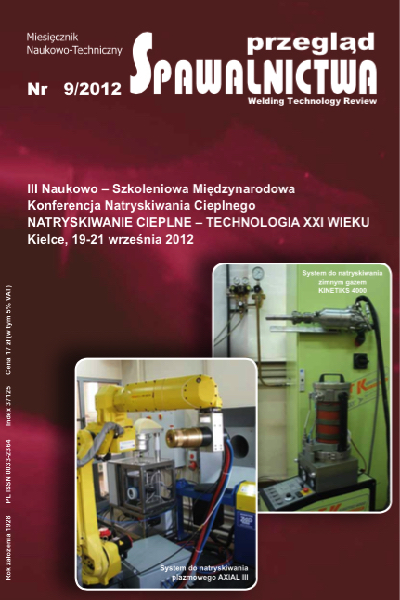Właściwości mechaniczne powłok hydroksyapatytu natryskiwanych plazmowo z zawiesin
Main Article Content
Abstract
W artykule przedstawiono wyniki oceny procesu natryskiwania plazmowego z zawiesin hydroksyapatytu (HA). Zawiesina proszku HA została wytworzona na bazie alkoholu etylowego i wody. Powłoki natryskiwano plazmowo na podłoża tytanowe. Proces nanoszenia powłok badano przy zmiennej odległości natryskiwania i mocy palnika. Do badań powłok zastosowano mikroskop skaningowy. Skład fazowy powłok określono na podstawie dyfraktogramów rentgenowskich. Stosując metodę mikroindentacji, zbadano twardość i moduł sprę- żystości natryskiwanych powłok.
Mechanical properties of suspension plasma sprayed hydroxyapatite coatings
Abstract
The paper presents the results of the evaluation of process of suspension plasma spraying of hydroxyapatite (HA). The suspension of HA powder is produced based on etanol and water. Coatings were plasma sprayed on titanium substrates. The coating was analyzed at varying distances and power of spray gum. To study of coatings used scanning electron microscope. Phase composition of coatings was determined on the basis of X-ray diffraction patterns. Hardness and modulus of elasticity of sprayed coatings were examined using a microindentation method.
Downloads
Article Details
Creative Commons CC BY 4.0 https://creativecommons.org/licenses/by/4.0/
Welding Technology Review (WTR) articles are published open access under a CC BY licence (Creative Commons Attribution 4.0 International licence). The CC BY licence is the most open licence available and considered the industry 'gold standard' for open access; it is also preferred by many funders. This licence allows readers to copy and redistribute the material in any medium or format, and to alter, transform, or build upon the material, including for commercial use, providing the original author is credited.
References
Williams D.F.: On the mechanism of biocompatibility, Biomaterials, 29 (2008), 2941-2953.
Yang Y., Kim K.- H., Ong J.L.: A review on calcium phosphate coatings produced using a sputtering processan alternative to plasma spraying, Biomaterials, 26 (2005), 327-337.
Gitzhofer F., Bouyer E., Boulous m.I.: Suspension plasma spraying. US Patent 5 609 921, 3 listopada 1997.
Killinger A., Gadow R., mauer G., Guignard A., Vassen R., Stover D.: Review of new developments in suspension and solution precursor thermal spray processes, Journal of Thermal Spray Technology, 20 (2011), 677-695.
Jaworski R., Pierlot C., Pawłowski L., Bigan m., Quivrin m.: Synthesis and preliminary tests of suspension plasma spraying of fine hydroxyapatite powder, Journal of Thermal Spray Technology, 17 (5-6) (2008), 679-684.
Jaworski R., Pierlot C., Pawłowski L., Bigan m., martel m.: Design of the synthesis of fine HA powder for suspension plasma spraying, Surface and Coatings Technology, 203 (2009), 2092-2097.
Pierlot C., Pawłowski L., Bigan m., Chagnon P.: Design of experiments in thermal spraying: A review, Surface and Coatings technology, 202 (2008), 4483-4490.
Prevey P.S.: X-ray diffraction characterization of crystallinity and phase composition in plasma-sprayed hydroxyapatite coatings, Journal of Thermal Spray Technology, 9 (2000), 369-376.
Quinn G.D., Patel P.L., Lloyd I.: Effect of loading rate upon conventional ceramic microindentation hardness, Journal of Research of the national Institute of Standards and Technology, 107 (2002), 299-306.
Olivier W.C., Pharr G.m.: An improved technique for determining hardness and elastic modulus using load and displacement sensing indentation experiments, Journal of materials Research, 7 (1992), 1564-1583.
Doener m.F., nix W.D.: A method of interpreting the data from the depth-sensing indentation instruments, Journal of materials Research, 1 (1986), 601-609.
Fischer-Cripps A.C.: Critical review of analysis and interpretation of nanoindentation test data, Surface and Coatings Technology, 200 (2006), 4153-4165.
Antunes J.m., menezes L.F., Fernandes J.V.: Threedimensional numerical simulation of Vickers indentation tests, International Journal of Solids and Structures, 43 (2006), 784-806.
Hay J.C., Bolshakov A., Pharr G.m.: Critical examination of the fundamental relations used in the analysis of nano-indentation data, Journal of materials Research, 14 (1999), 2296-2305.
Charriere E., Terrazzoni S., Pittet C., mordasini Ph., Dutoit m., Lemaitre J., Zysset Ph.: mechanical characterization of brushite and hydroxyapatite cements, Biomaterials, 22 (2001), 2937-2945.
Cheng Y.T., Cheng C.m.: Scaling dimensional analysis and indentation measurements, material Science and Engineering: R: Reports, 44 (2004), 91-149.
Chicot D.: Hardness length-scale factor to model nano- and microindentation size effects, materials Science and Engineering: A, 499 (2009), 454-461.
Zeng K., Chiu C.H.: An analysis of load-penetration curves from instrumented indentation, Acta materialia, 49 (2001), 3539-3551.
